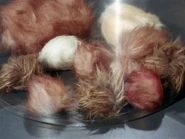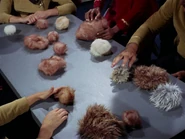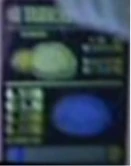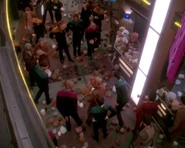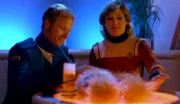(Adding categories) |
(Adding categories) |
||
| Line 55: | Line 55: | ||
[[Category:Mammalian Species]] |
[[Category:Mammalian Species]] |
||
[[Category:Aliens Portrayed by Animals]] |
[[Category:Aliens Portrayed by Animals]] |
||
| + | [[Category:Aliens on Earth]] |
||
Revision as of 19:49, 26 September 2021
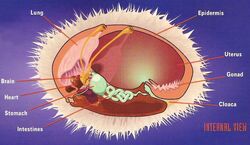
The inner workings of a Tribble
Tribbles are a species of small alien lifeforms which do little more than eating and reproducing constantly. These furry, rounded herbivorous creatures with no visible features come in several shades of brown, grey, cream, white or pink; can be from about ten to thirty centimeters long and move around by crawling rapidly or rolling.
Biology
Tribbles are physically harmless, but can be quite a problem due to their perpetual hunger and fast reproduction, as they reproduce asexually and are born pregnant. They emit purring sounds and are known to have a tranquilizing effect in the nervous system of Humans and possibly other species. Klingons on the other hand detest Tribbles and consider them a nuisance and a pest; causing Tribbles to become scared and agitated whenever they approach a member of the Klingon species. Captain Kirk once took advantage of this and successfully used a tribble to identify a Klingon spy disguised as Human.
History
The Tribble homeworld is called Iota Geminorum IV and is also home to reptilian predators which keep the population in check. Once off their homeworld, however, they can reproduce uncontrollably and become an invasive species. Genetic engineering was once used to attempt to make the tribbles safer by eliminating their ability to reproduce. At first, the affected tribbles appeared to be increasing in size, but it was soon discovered that they were still reproducing, but remaining together and forming tribble colonies. The situation was solved by Dr. McCoy, who found out that neo-ethylene would allow the tribble colonies to break apart and also cause the individual tribbles to have a slower metabolic rate.
In spite of this, in some point after these events the Klingons decided to end the tribble "pest menace" by bombarding the tribble homeworld, driving the species extinct. When the crew of space station Deep Space 9 traveled to the past to prevent the assassination of James T. Kirk by a Klingon agent, they also managed to bring a few tribbles to the 24th century, successfully reintroducing the species.
Appearances
- Star Trek, s02e13, "The Trouble with Tribbles" (1967)
- Star Trek: The Animated Series, s01e05, "More Tribbles, More Troubles" (1973)
- Star Trek III: The Search for Spock (1984)
- Star Trek: Deep Space Nine, s05e06, "Trials and Tribble-ations" (1996)
- Star Trek: Enterprise, s02e21, "The Breach" (2003)
- Star Trek Into Darkness (2013)
Gallery
Notes
- They are similar to the Martian Flat Cats from Robert Heinlein's The Rolling Stones. Writer David Gerrold, who created the Tribble species, was unaware of that at first, but when he found out about the book he asked for Heinlein's permission, which Heinlein granted in exchange for an autographed copy of the episode's script.
- In the book Evolving the Alien: The Science of Extraterrestrial Life, a.k.a. What Does a Martian Look Like?, Dr. Jack Cohen and Ian Stewart surprisingly elect the tribble one of the most realistic alien species in Star Trek and describe a thoroughly detailed alien ecosystem scenario to justify how such a creature could have evolved.
- The sounds of the tribbles came from altered dove coos, owl screeches, and empty balloons.
